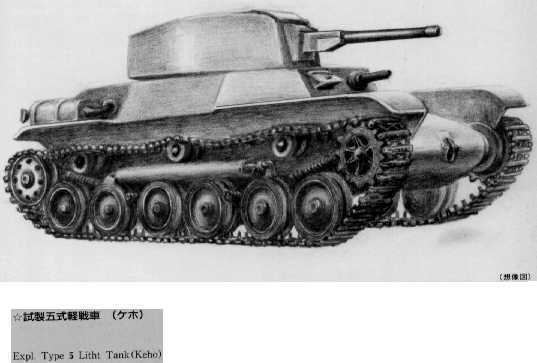Type Light tank Designed 1942 No. built 1 (prototype) | Place of origin Empire of Japan Produced 1945 Weight 10 tons | |
 | ||
The Type 5 light tank Ke-Ho (五式軽戦車 ケホ, Go-shiki keisensha Keho) was a prototype light tank developed by the Imperial Japanese Army at the end of World War II.
Contents
History and development
In 1938, development began for a new light tank for the Japanese army. While the Type 95 Ha-Go had performed well against the National Revolutionary Army of the China in the Second Sino-Japanese War and successfully engaged United States M3 Stuart light tanks on the Bataan Peninsula in December 1941, it was quickly growing obsolete. Although its 37mm gun was adequate for most light armor designed and built in the 1930s, the Ha-Go, like the tanks of the US Army prior to 1941, was not designed to fight enemy tanks, but rather to support the infantry. The Type 95's light armor made it vulnerable to .50 caliber machine gun fire and attempts to address these shortcomings via the Type 98 Ke-Ni and the Type 2 Ke-To were steps in the right direction, but were still insufficient. Therefore, a complete design review was held and a prototype for a new standard light tank was completed by 1942. At this point the project was shelved, as the Imperial Japanese Army General Staff had to concede to the Imperial Navy's needs of raw materials necessary for the production of warships and warplanes. Mass production was finally authorized in 1945, by which time it was too late. Production was impossible due to shortages of materials such as steel, and the bombing of Japan. Only a single prototype was completed by the end of World War II.
Armor
The Type 5 Ke-Ho had armor of up to 20 mm, and a Type 1 47 mm main gun, an improvement over existing Japanese light tanks. The tank weighed 9 tonnes due to increased armor thickness and a bigger engine. Turret layout drew previous design experience from Type 97 Chi-Ha and Type 1 Chi-He.
Mobility
It was powered by an air cooled diesel engine yielding 150 HP, for a top speed of 50 km/h. Details about the engine design still remains unknown. One theory indicates it was an improved version of the Chiyoda EC engine manufactured by Tokyo Gas and Electronics Industry in 1937. The tank also had a fuel tank capacity of 130 L.
